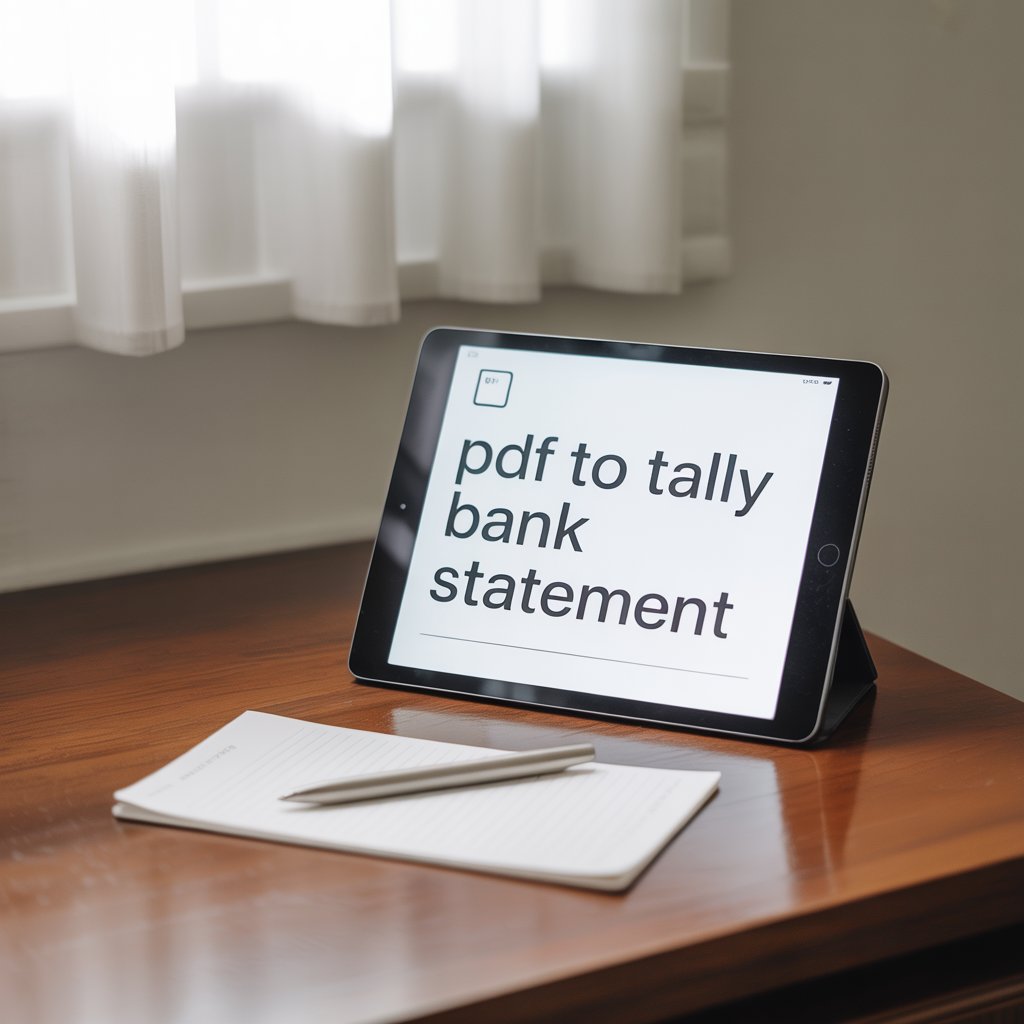Bank statements are critical financial documents that serve as official records of your account transactions. Whether you’re dealing with accounting software like Tally, preparing for loan applications, or organizing your financial records, you might wonder about editing bank statement PDFs. This comprehensive guide explores the technical aspects, legal considerations, and legitimate purposes for handling bank statement documents.
Understanding Bank Statement PDFs
Bank statements in PDF format are digital copies of your official banking records. These documents contain detailed information about your account activity, including deposits, withdrawals, interest earned, and fees charged during a specific period. Most banks now provide statements in PDF format through online banking platforms, making them easily accessible and storable.
The PDF format is particularly popular because it preserves the original formatting and layout of documents while being compatible across different devices and operating systems. However, this same security feature that makes PDFs reliable also makes them challenging to modify.
Technical Possibilities for Editing PDFs
From a purely technical standpoint, PDF editing is possible using various software tools and methods. Several approaches exist for modifying PDF content:
Professional PDF Editors like Adobe Acrobat Pro, Foxit PhantomPDF, and PDFelement offer comprehensive editing capabilities. These tools allow users to modify text, images, and formatting within PDF documents. However, bank statements often contain security features that may prevent or limit editing functionality.
Online PDF Editors provide web-based solutions for basic PDF modifications. While convenient, these platforms may have limitations when dealing with protected or secured documents like bank statements.
Text Recognition Software can convert PDF content into editable formats. Optical Character Recognition (OCR) technology can extract text from PDF images, potentially allowing for modifications before converting back to PDF format.
Developer Tools and Scripts offer advanced users programmatic methods to manipulate PDF content. Programming languages like Python have libraries specifically designed for PDF manipulation.
Legal and Ethical Considerations
While technical editing capabilities exist, the legal implications of modifying bank statements are severe and must be clearly understood. Altering official financial documents can constitute fraud, forgery, or document tampering, depending on the jurisdiction and intended use.
Fraudulent Activities involving altered bank statements can result in criminal charges, substantial fines, and imprisonment. Financial institutions, lenders, and regulatory bodies have sophisticated methods for detecting document tampering.
Civil Consequences may include loan denial, account closure, civil lawsuits, and permanent damage to your credit history and financial reputation.
Professional Implications can affect licensed professionals who might face disciplinary action, license suspension, or revocation for involvement in document falsification.
Legitimate Reasons for PDF Editing
Despite the serious legal concerns, there are legitimate scenarios where PDF editing might be considered:
Privacy Protection involves redacting sensitive information like account numbers or social security numbers when sharing statements for specific purposes. This type of editing focuses on protecting personal information rather than altering financial data.
Format Conversion for accounting software compatibility may require restructuring PDF data. When working with pdf to tally bank statement imports, you might need to adjust formatting to ensure proper data recognition by the software.
Correcting OCR Errors that occur during digital conversion processes. Sometimes, scanned documents contain text recognition mistakes that need correction for clarity.
Combining Multiple Statements into a single document for organizational purposes. This involves merging rather than altering individual statement content.
Converting PDF to Tally Bank Statement Format
For businesses using Tally accounting software, importing bank statement data efficiently is crucial for maintaining accurate financial records. The process of converting pdf to tally bank statement format involves several considerations and methods.
Understanding Tally Requirements is essential before beginning any conversion process. Tally ERP expects bank statement data in specific formats, typically Excel or CSV files with properly structured columns for dates, descriptions, debit amounts, credit amounts, and running balances.
Data Extraction Methods for converting PDF statements to Tally-compatible formats include manual data entry, OCR software utilization, and specialized conversion tools. Each method has advantages and limitations regarding accuracy, time investment, and cost considerations.
Bank Statement Conversion Tools specifically designed for accounting software integration can streamline the pdf to tally bank statement conversion process. These tools often include features like automatic column mapping, duplicate transaction detection, and error correction capabilities.
Quality Assurance Steps should always follow conversion processes to ensure data accuracy. Comparing converted data against original PDF statements helps identify any discrepancies or errors that might affect your accounting records.
Best Practices for Handling Bank Statement PDFs
When working with bank statement PDFs, following established best practices helps maintain document integrity while meeting your legitimate business needs.
Secure Storage Solutions protect your financial documents from unauthorized access while ensuring easy retrieval when needed. Cloud storage services with encryption, password-protected folders, and regular backup procedures provide comprehensive document security.
Version Control Systems help track document changes and maintain audit trails. When legitimate modifications are necessary, documenting the reasons, dates, and nature of changes creates transparency and accountability.
Regular Reconciliation Processes between PDF statements and accounting records help identify discrepancies early. This practice is particularly important when using pdf to tally bank statement conversion processes.
Professional Consultation with accountants, legal advisors, or financial professionals can provide guidance on proper document handling procedures and compliance requirements specific to your situation.
Alternative Solutions
Rather than editing bank statements directly, consider these alternative approaches that achieve similar objectives while maintaining document integrity:
Request Corrected Statements from your bank when genuine errors exist. Financial institutions have procedures for investigating and correcting mistakes in customer statements.
Use Bank APIs for automated data extraction. Many banks offer Application Programming Interfaces that allow secure, real-time access to transaction data for integration with accounting software.
Implement Bank Reconciliation Software that can work with original PDF statements while providing the formatting and analysis tools needed for effective financial management.
Maintain Supplementary Documentation to explain unusual transactions or provide additional context without altering the original statement content.
Conclusion
While editing bank statement PDFs is technically possible, the legal and ethical implications make it inadvisable in most circumstances. The risks associated with document alteration far outweigh any perceived benefits, particularly given the availability of legitimate alternatives.
For businesses needing to convert pdf to tally bank statement formats, focus on extraction and conversion methods that preserve original document integrity while meeting software requirements. Professional tools and services can facilitate this process without compromising document authenticity.
The key to successful bank statement management lies in understanding your legitimate needs, exploring appropriate solutions, and maintaining the highest standards of document integrity. When in doubt, consult with financial professionals who can guide you toward compliant and effective document handling practices.
Q: Is it legal to edit bank statement PDFs?
A: Editing bank statements for fraudulent purposes is illegal and can result in serious criminal charges. Only very specific circumstances, such as redacting personal information for privacy protection, might be considered legitimate.
Q: Can banks detect if I’ve edited a PDF statement?
A: Yes, banks and financial institutions have sophisticated tools and methods for detecting document tampering. Digital forensics can often reveal evidence of alterations even in professionally edited documents.
Q: How can I convert pdf to tally bank statement format legally?
A: Use legitimate conversion tools that extract data from original PDFs without altering the source documents. Focus on reformatting extracted data rather than modifying the original statement content.
Q: What should I do if my bank statement contains errors?
A: Contact your bank immediately to report any errors. Banks have established procedures for investigating and correcting genuine mistakes in customer statements.
Q: Are there professional services for bank statement conversion?
A: Yes, many accounting firms and specialized service providers offer legitimate bank statement conversion services that maintain document integrity while providing the formatting needed for various accounting software platforms.
Q: Can I remove my account number from a PDF statement for privacy?
A: Redacting sensitive information like account numbers for privacy protection may be acceptable in certain contexts, but you should consult with legal professionals to ensure compliance with applicable regulations and requirements.







0 Comments